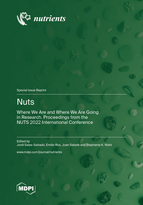Nuts: Where We Are and Where We Are Going in Research. Proceedings from the NUTS 2022 International Conference
A special issue of Nutrients (ISSN 2072-6643). This special issue belongs to the section "Nutritional Epidemiology".
Deadline for manuscript submissions: closed (31 January 2023) | Viewed by 56041
Special Issue Editors
CIBER Fisiopatología de la Obesidad y Nutrición (CIBEROBN), Instituto de Salud Carlos III, Madrid, Spain
Interests: nutritional epidemiology; clinical trials; obesity; diet and diabetes; effect of food and their components on health and disease; dietary patterns; diet and cardiovascular disease
2. Lipid Clinic, Department of Endocrinology and Nutrition, Institut d'Investigacions Biomèdiques August Pi Sunyer (IDIBAPS), Hospital Clínic, 08036 Barcelona, Spain
Interests: nutrition in the prevention of cardiovascular diseases and cognitive decline with special interest in the Mediterranean diet and walnuts; plant sterols; blood membrane fatty acids; genetic dyslipidemias; cardiovascular risk assessment; and vascular imaging techniques, especially carotid ultrasound
Special Issues, Collections and Topics in MDPI journals
Interests: health effects of plant foods; nuts and cognition; dietary assessment tools and methods; environmental nutrition and sustainable diets; plant-based dietary food patterns and health outcomes
2. Institut d'Investigació Sanitària Pere Virgili (IISPV), Reus, Spain
3. Centro de Investigación Biomédica en Red Fisiopatología de la Obesidad y la Nutrición (CIBEROBN), Institute of Health Carlos III, Madrid, Spain
4. Toronto 3D (Diet, Digestive Tract and Disease) Knowledge Synthesis and Clinical Trials Unit, Toronto, ON, Canada
5. Clinical Nutrition and Risk Factor Modification Centre, St. Michael’s Hospital, Unity Health Toronto, ON, Canada
Special Issue Information
Dear Colleagues,
NUTS2022 (https://nuts2022.com/) is an international scientific meeting that will take place in Reus (Spain) on 20–21 October 2022. We want to take advantage of the high quality of the Nutrients journal in order to publish the proceedings from this important meeting that will gather different worldwide experts in the nut/dried fruits–disease axis. We plan on publishing at least 10 manuscripts following these key topics: (1) nuts, energy balance, and body weight; (2) nuts, insulin resistance, and diabetes; (3) nuts, lipoproteins, and dyslipidemia; (4) nuts and the gastrointestinal system; (5) nuts, inflammation, and oxidation; (6) nuts and cardiovascular disease outcomes; (7) nut consumption, aging, and cognition; (8) nuts and cancer; (9) dried fruit and health; and (10) future lines of research.
Prof. Dr. Jordi Salas-SalvadóProf. Dr. Emilio Ros
Prof. Dr. Joan Sabaté
Dr. Stephanie K. Nishi
Guest Editors
Manuscript Submission Information
Manuscripts should be submitted online at www.mdpi.com by registering and logging in to this website. Once you are registered, click here to go to the submission form. Manuscripts can be submitted until the deadline. All submissions that pass pre-check are peer-reviewed. Accepted papers will be published continuously in the journal (as soon as accepted) and will be listed together on the special issue website. Research articles, review articles as well as short communications are invited. For planned papers, a title and short abstract (about 100 words) can be sent to the Editorial Office for announcement on this website.
Submitted manuscripts should not have been published previously, nor be under consideration for publication elsewhere (except conference proceedings papers). All manuscripts are thoroughly refereed through a single-blind peer-review process. A guide for authors and other relevant information for submission of manuscripts is available on the Instructions for Authors page. Nutrients is an international peer-reviewed open access semimonthly journal published by MDPI.
Please visit the Instructions for Authors page before submitting a manuscript. The Article Processing Charge (APC) for publication in this open access journal is 2900 CHF (Swiss Francs). Submitted papers should be well formatted and use good English. Authors may use MDPI's English editing service prior to publication or during author revisions.
Keywords
- nuts
- dried fruits
- research
- clinical trial
- epidemiological
- body weight
- inflammation
- oxidation
- cardiovascular disease
- insulin resistance
- diabetes
- dyslipidemia
- aging
- cancer
- future










